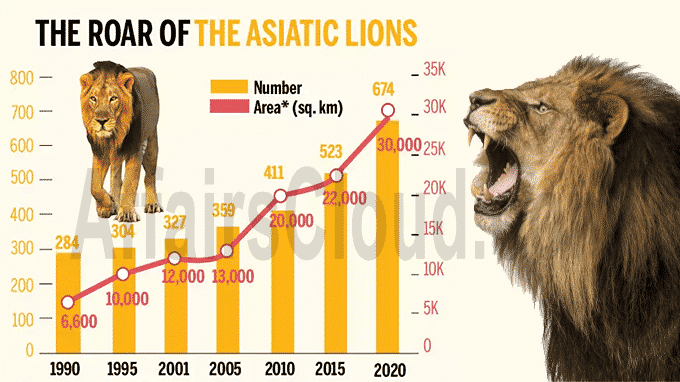 According to the “Poonam Avlokkan” survey the population of the Asiatic lion at the Gir sanctuary in Gujarat has seen a commendable rise to approximately 29% (28.87%) from 27% in 2015 i.e their population went from 523 in 2015 to 674 in 2020.
According to the “Poonam Avlokkan” survey the population of the Asiatic lion at the Gir sanctuary in Gujarat has seen a commendable rise to approximately 29% (28.87%) from 27% in 2015 i.e their population went from 523 in 2015 to 674 in 2020.
Subsequently the distribution area of the lions was also increased to 36% from 22,000sq Km in 2015 to 30,000 sq Km in 2020.
Note: This was an alternate approach for the counting of the Lion population instead of the Census in Gujarat’s Gir forest due to the COVID -19 pandemic requiring more officials for policing duties.
About Poonam Avlokan exercise
It is an observation method carried out monthly and during every full-moon, all the officers and field staff members assess the number of lions for 24 hours across various areas within their respective jurisdictions.
The exercise for the 2020 data included 10 districts where lions have been spotted over the years in 13 forest divisions which are a part of the Lion census.
Key Points
i.The Asiatic lions are found in protected areas and agro-pastoral regions of Saurashtra covering about 9 districts in the Gir forest.
ii.According to Prime Minister Modi the steady rise in the population of lions is an influence of the community participation in wildlife health-care and the proper habitat management to minimize human-lion conflict and other conservative methods.
About Gir National Park and Wildlife Sanctuary
The Gir National Park and Wildlife Sanctuary is located in the Junagadh district of Gujarat. It is the largest compacted dry deciduous forest in the western region of India. It was declared a sanctuary in 1965. Is it the only place in the world to host the Asiatic lion, an endangered animal species.
It also houses a number of species of exotic birds and animals in its flourishing flora and fauna. It covers about 1153.42 sq. km area out of which an area of 258.71 sq. km. was declared a National Park.




